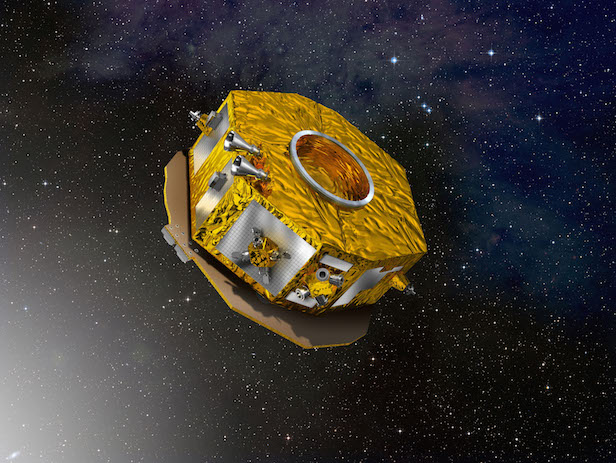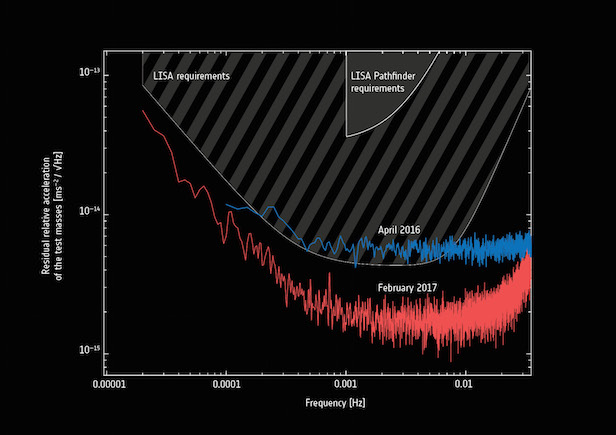LISA Pathfinder outshone its expectations
The new results have laid excellent foundations for ESA’s future LISA mission in 2034

LPF tested the technologies that will eventually detect low-frequency gravitational waves within the cosmos. Image credit: ESA/D. Ducros
The final results from the European Space Agency’s test satellite LISA Pathfinder (LPF) seem to surpass all expectations of its interferometer abilities. The final set of data was taken in July 2017, and were carefully analysed by researchers at the Max Planck Institute for Gravitational Physics in Hannover and Leibniz Universität Hannover. These results have been a vast improvement on the first set of results, published in mid 2016, showcasing that the key technologies necessary for its successor LISA to detect the tiniest ripples in spacetime, also known as gravitational waves.
“LISA Pathfinder beautifully demonstrated the key technologies for LISA, the future gravitational-wave observatory in space: the perfect undisturbed free fall of two cubic test masses inside the spacecraft,” says Prof. Karsten Danzmann, director at the Max Planck Institute for Gravitational Physics and the Institute for Gravitational Physics at Leibniz Universität Hannover, who also is the Co-Principal Investigator of the LISA Technology Package. “We were blown away by the results in the first weeks of the mission, but our final results, using more and better data and a deeper understanding of our space laboratory LPF, really are a sight to behold.”
LPF had already exceeded its requirements at high frequencies (above 0.01 Hz) within the first set of results. Now the new results have gone even further, as they beat the expectations by more than a factor of two all the way down to 0.00002 Hz, which is the entire LISA frequency band. This is a great sign for ESA’s expected launch in 2034, where it will “listen” to merging supermassive black holes throughout the universe.

The results of LPF in February 2017 have clearly surpassed scientists’ expectations by a great margin, setting high hopes for the future LISA mission in 2034. Image credit: ESA
The LPF researchers introduced many different actions to improve the initial results and reduce background noise, creating the optimal environment for the two cubic gold-platinum test masses. After months of venting the test mass vacuum chambers to space, the remaining gas pressure that limited prior measurements dropped by a factor of 10. As more data became available, the small inertial forces working acting on the cubes, due to the spacecraft’s orbit and orientation in space, became more apparent and were able to be accounted for. The onboard electrostatic forces, caused by the electrical systems and magnetic fields, create a problem for such a sensitive instrument, meaning the researchers had to eliminate that too. Finally, statistical analysis then led to the researchers removing any glitches from the data, allowing for a better reading at lower frequencies.
These two test masses, also the first laser interferometer in space, have proved better than possibly thought. They have shown to be 100 times better than its requirements and 30 times better than any ground-based laboratory. This high precision allows for a detailed examination of more subtle noise sources and artefacts, thus leading to more valuable information and experience that can prove vital for the eventual LISA mission’s success. Scientists at the Max Planck and Leibniz Universität, Hannover led the construction of the precise optical measurement system.
When LISA is launched in 2034 by the European Space Agency, it will consist of three satellites creating an equilateral triangle, with each side never expanding or contracting more than 2.5 million kilometres (8.2 million miles) apart. If a gravitational wave were to pass through LISA, it will be able to detect a distance change of up to a trillionth of a metre. This future space interferometer will specialise in low-frequency gravitational waves, with oscillation periods ranging from 10 seconds and 12 hours. These events most commonly occur in the merger of supermassive black holes, with masses equalling millions times the mass of our Sun, at the centre of our galaxy. They can also be emitted from the highly intense orbital motions of binary stars (two stars orbiting each other) and possibly exotic resources such as cosmic strings.
Keep up to date with the latest reviews in All About Space – available every month for just £4.99. Alternatively you can subscribe here for a fraction of the price!




